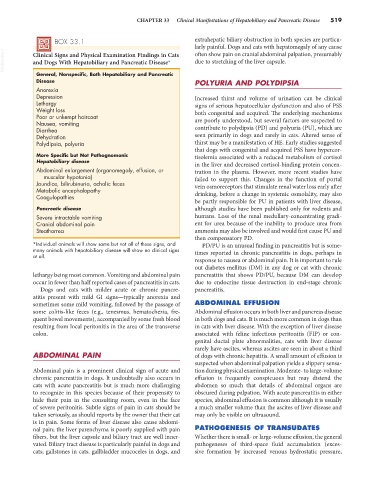Page 547 - Small Animal Internal Medicine, 6th Edition
P. 547
CHAPTER 33 Clinical Manifestations of Hepatobiliary and Pancreatic Disease 519
BOX 33.1 extrahepatic biliary obstruction in both species are particu-
larly painful. Dogs and cats with hepatomegaly of any cause
VetBooks.ir Clinical Signs and Physical Examination Findings in Cats often show pain on cranial abdominal palpation, presumably
due to stretching of the liver capsule.
and Dogs With Hepatobiliary and Pancreatic Disease*
General, Nonspecific, Both Hepatobiliary and Pancreatic
Disease POLYURIA AND POLYDIPSIA
Anorexia
Depression Increased thirst and volume of urination can be clinical
Lethargy signs of serious hepatocellular dysfunction and also of PSS
Weight loss both congenital and acquired. The underlying mechanisms
Poor or unkempt haircoat
Nausea, vomiting are poorly understood, but several factors are suspected to
Diarrhea contribute to polydipsia (PD) and polyuria (PU), which are
Dehydration seen primarily in dogs and rarely in cats. Altered sense of
Polydipsia, polyuria thirst may be a manifestation of HE. Early studies suggested
that dogs with congenital and acquired PSS have hypercor-
More Specific but Not Pathognomonic tisolemia associated with a reduced metabolism of cortisol
Hepatobiliary disease in the liver and decreased cortisol-binding protein concen-
Abdominal enlargement (organomegaly, effusion, or tration in the plasma. However, more recent studies have
muscular hypotonia) failed to support this. Changes in the function of portal
Jaundice, bilirubinuria, acholic feces vein osmoreceptors that stimulate renal water loss early after
Metabolic encephalopathy
Coagulopathies drinking, before a change in systemic osmolality, may also
be partly responsible for PU in patients with liver disease,
Pancreatic disease although studies have been published only for rodents and
Severe intractable vomiting humans. Loss of the renal medullary-concentrating gradi-
Cranial abdominal pain ent for urea because of the inability to produce urea from
Steathorrea ammonia may also be involved and would first cause PU and
then compensatory PD.
*Individual animals will show some but not all of these signs, and PD/PU is an unusual finding in pancreatitis but is some-
many animals with hepatobiliary disease will show no clinical signs times reported in chronic pancreatitis in dogs, perhaps in
at all.
response to nausea or abdominal pain. It is important to rule
out diabetes mellitus (DM) in any dog or cat with chronic
lethargy being most common. Vomiting and abdominal pain pancreatitis that shows PD/PU, because DM can develop
occur in fewer than half reported cases of pancreatitis in cats. due to endocrine tissue destruction in end-stage chronic
Dogs and cats with milder acute or chronic pancre- pancreatitis.
atitis present with mild GI signs—typically anorexia and
sometimes some mild vomiting, followed by the passage of ABDOMINAL EFFUSION
some colitis-like feces (e.g., tenesmus, hematochezia, fre- Abdominal effusion occurs in both liver and pancreas disease
quent bowel movements), accompanied by some fresh blood in both dogs and cats. It is much more common in dogs than
resulting from local peritonitis in the area of the transverse in cats with liver disease. With the exception of liver disease
colon. associated with feline infectious peritonitis (FIP) or con-
genital ductal plate abnormalities, cats with liver disease
rarely have ascites, whereas ascites are seen in about a third
ABDOMINAL PAIN of dogs with chronic hepatitis. A small amount of effusion is
suspected when abdominal palpation yields a slippery sensa-
Abdominal pain is a prominent clinical sign of acute and tion during physical examination. Moderate- to large-volume
chronic pancreatitis in dogs. It undoubtedly also occurs in effusion is frequently conspicuous but may distend the
cats with acute pancreatitis but is much more challenging abdomen so much that details of abdominal organs are
to recognize in this species because of their propensity to obscured during palpation. With acute pancreatitis in either
hide their pain in the consulting room, even in the face species, abdominal effusion is common although it is usually
of severe peritonitis. Subtle signs of pain in cats should be a much smaller volume than the ascites of liver disease and
taken seriously, as should reports by the owner that their cat may only be visible on ultrasound.
is in pain. Some forms of liver disease also cause abdomi-
nal pain; the liver parenchyma is poorly supplied with pain PATHOGENESIS OF TRANSUDATES
fibers, but the liver capsule and biliary tract are well inner- Whether there is small- or large-volume effusion, the general
vated. Biliary tract disease is particularly painful in dogs and pathogeneses of third-space fluid accumulation (exces-
cats; gallstones in cats, gallbladder mucoceles in dogs, and sive formation by increased venous hydrostatic pressure,

